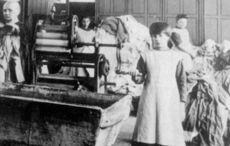My image of the South and the Civil War was formed in part by the movie Gone With the Wind. RTÉ, our one channel when I was growing up in Ireland, ran movie classics on Sunday afternoons. It was one of the features I enjoyed watching with my mother.
My desire to come to America was fueled by those movies, by the glamour of Fred Astaire and Ginger Rogers, and the talent of Bing Crosby and Gene Kelly. And, of course, Clark Gable, who was my mother’s favorite.
And when I did come to America “for the summer” (I arrived on July 4, 1972, which I always refer to as MY Independence Day), I took a trip around the States that ended in Hollywood, where I took a photograph of Clark’s hand prints on the Walk of Fame and mailed it to my mother.
I didn’t think about there being an Irish dimension to those Sunday movies. (Of course, years later I would interview Gregory Peck who was so proud of his Kerry roots, and Gene Kelly would also feature in our pages). The fact that Scarlett was an “O’Hara” and her plantation was called “Tara” didn’t register as anything out of the ordinary back then. But as David O’Connell, writing in this issue, shows us, Margaret Mitchell, the author of Gone With the Wind, published 75 years ago and still selling strong, was very Irish indeed.
On that same trip around the States in 1972, I stopped in Medicine Bow, Wyoming, the town where The Virginian was set. (In addition to American movies, TV shows such as Wagon Train, Have Gun Will Travel, and The Virginian, were our viewing staple). Back then, I didn’t think of cowboys, sheriffs, cattle rustlers and outlaws as being Irish, but of course, many of the most colorful characters in the Wild West were Irish, including Billy the Kid.
A photograph of Billy sold for $2.3 million recently, and at about the same time, Whitey Bulger, another Irish outlaw, was arrested. In this issue, Tom Deignan takes a close look at these two Irish outlaws and the movies that have been made about them.
If America has its outlaws, it also has its super heroes, and in this issue, Tara Dougherty interviews “Spider-Man” Reeve Carney. Reeve’s great-uncle was Art Carney of Honeymooners fame. (Jackie Gleason may have had star billing but to my mind, Carney carried the show). The Honeymooners was one of my favorite shows when I first moved here. I still watch the reruns. So, I’m delighted to have the talented Reeve, who is well up on his Irish roots, featured in this issue.
I don’t know if Brendan Gleeson is any relation to Jackie Gleason, but I’m sure you will enjoy Sheila Langan’s cover story on this fine actor who has played some very bad guys – though he always infuses them with a bit of humanity. He has a wonderful new film The Guard coming out so watch for it in cinemas soon.
Of course, movies are not real life and the Civil War is certainly a lot more complex than what I gleaned from Gone With the Wind, but my real surprise on coming to America, was finding out how Irish it is. For such a small country we sure have had an impact. The recent visit by President Obama to Ireland served as an opportunity to look at other visits by U.S. presidents who had Irish ancestors, including an 1872 trip by Ulysses S. Grant, and we are delighted to bring you that story too. Isn’t it something that the home of Obama’s ancestors is still lived in by family members? And indeed, Grant’s family homestead is also still standing. (I always had a thing for Grant, I think it’s because he looks like one of the heroes of those American westerns.)
With presidential visits and capturing outlaws, the Irish have been in the news of late – not least of all because of Rory McIlroy’s U.S. Open win. But there’s another golfing hero that we remember in this issue, 19-year-old John McDermott, who won the U.S. Open in 1911. He was the first American to do so, and he just happened to be Irish American.
So, lots of good reading in this issue. And don’t forget to check out our Photo Album page. The short profiles readers submit about the lives of their ancestors are the real story of how the Irish made it in America. In the last issue, Thomas Delaney, who fought in the Civil War, had his story told by his great-grandson Gerry Howard. Thomas Delaney, another great-grandson, read the story and contacted the magazine, and we were able to connect these two long lost cousins.
Now, that’s the stuff of movies.
Mortas Cine




Comments